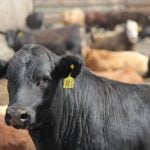Carl Dornn knew he was onto something three years ago when he introduced a milk replacer to a hog operation he owned with his brother near Sidney, Man.
Dornn said the piglets’ general health improved, there were fewer deaths, and the animals posted better weight gains
That convinced him to begin selling the milk replacer through his company, Creative Feeds Inc.
The company now markets milk replacer systems across the Prairies. The milk supplement is produced by Ralco Mix Products Inc. of Minnesota, and is sold under the brand name Advanced Birthright Nutrition.
Read Also

Trump’s tariffs take their toll on U.S. producers
U.S. farmers say Trump’s tariffs have been devastating for growers in that country.
The systems are designed to provide milk supplement to piglets within 12 to 24 hours of birth.
The supplement is not given immediately at birth so that the newborn pigs first nurse from their mother and get colostrum.
The piglets typically receive the supplement until they are 14 days old. Then they are weaned onto solid food.
More available milk means weaker piglets can get the nutrition they need. Dornn said fewer dead piglets is one of the main benefits of the supplement.
The milk replacer also tends to mean heavier pigs at weaning time.
Dornn said studies show that improved gains at the infant stage will typically translate into better weight gains throughout the pig’s life.
“We want to prevent small, non-thrifty pigs by supplementing the milk from day one.”
The Starlite Hutterite Colony near Starbuck, Man., has been using the Creative Feeds milk replacer for almost two years.
While the system has not necessarily meant higher weaning weights, the colony’s hog operations manager said it has meant a decline in infant pig mortality of one to two percent.
“If I was to build a barn from scratch, this system would be in there from day one,” James Hofer said.
The Creative Feeds milk replacer system pumps milk through lines to a cup in each farrowing pen. The piglets are taught how to feed from the cup but only after they have learned to suckle from their mother.
The average number of piglets produced per sow in Western Canada is gradually increasing. The larger litters put more demand on sows for milk.
That was the experience at the Starlite Colony. The colony averaged a dozen live pigs per litter during an 11 month period.
“There was no way you could physically get every sow to suckle 12 piglets,” Hofer said. The less aggressive piglets were the ones that needed the supplement most because they had a harder time competing for their mothers’ milk.
Hofer could think of no drawbacks to the milk replacer system. Scours were not an issue. However, he did note that the cups need to be placed where the sow can’t reach them or she will also drink the supplement.
“The surprising thing was the way the piglets took to it. There must be something in that milk that brings them back.”
Lennard Tanguay manages a farrow-to-wean operation for C&E Farms near Sidney. The Creative Feeds milk replacer has meant better weight gains and fewer deaths among infant pigs.
“You can raise a whole lot more pigs per sow,” Tanguay said. “There are no starve-outs anymore.”
C & E Farms averages 12 to 13 pigs per litter. Tanguay learned early that it’s important to get newborn piglets suckling from the mother before introducing them to the supplement. Otherwise, there is a chance the piglets will feed only from the supplement dispenser rather than from the sow, he said.
“They definitely love it.”














